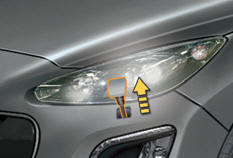Wiper controls
System for selection and control of the various front and rear wiping modes for the elimination of rain and cleaning.
The vehicle's front and rear wipers are designed to improve the driver's visibility progressively according to the climatic conditions.
Programming
Various automatic wiper control modes are also available according to the following options:
- automatic rain sensitive windscreen wipers,
- rear wiping on engaging reverse gear.
Model without AUTO wiping

Model with AUTO wiping

Manual controls
The wiper commands are issued directly by the driver by means of the stalk A and the ring B .
Windscreen wipers
A. Wiping speed selection stalk.
 Fast (heavy rain).
Fast (heavy rain).
 Normal (moderate rain).
Normal (moderate rain).
 Intermittent (proportional to the
speed of the vehicle).
Intermittent (proportional to the
speed of the vehicle).
 Off.
Off.
 Single wipe (press down and release).
Single wipe (press down and release).
or
 Automatic, then single wipe (see
the corresponding section).
Automatic, then single wipe (see
the corresponding section).
Rear wiper

 If a significant accumulation
of snow or ice is present, or when using a tailgate bicycle carrier, deactivate
the automatic rear wiper via the multifunction screen configuration menu.
If a significant accumulation
of snow or ice is present, or when using a tailgate bicycle carrier, deactivate
the automatic rear wiper via the multifunction screen configuration menu.
B. Rear wiper selection ring:
 park,
park,
 intermittent wipe,
intermittent wipe,
 wash-wipe (set duration).
wash-wipe (set duration).
Reverse gear
When reverse gear is engaged, the rear wiper will come into operation if the windscreen wipers are operating.
Programming
 The function is activated or deactivated
via the vehicle configuration menu.
The function is activated or deactivated
via the vehicle configuration menu.
This function is activated by default.
Windscreen and headlamp wash

Pull the windscreen wiper stalk towards you. The windscreen wash then the windscreen wipers operate for a fixed period.
The headlamp washers only operate when the dipped beam headlamps are on .
Screenwash/headlamp wash low
 In the case of vehicles fitted with
headlamp washers, when the minimum level of the reservoir is reached, this warning
lamp and/or the service warning lamp is displayed in the instrument panel, accompanied
by an audible signal and a message in the screen.
In the case of vehicles fitted with
headlamp washers, when the minimum level of the reservoir is reached, this warning
lamp and/or the service warning lamp is displayed in the instrument panel, accompanied
by an audible signal and a message in the screen.
Next time you stop, fi ll the screenwash / headlamp wash fluid reservoir.
The warning lamp is displayed when the ignition is switched on, or every time the stalk is operated, until the reservoir is fi lled.
Automatic rain sensitive windscreen wipers
The windscreen wipers operate automatically, without any action on the part of the driver, if rain is detected (sensor behind the rear view mirror), adapting their speed to the intensity of the rainfall.

Activation
This is controlled manually by the driver by pushing the stalk downwards to the "AUTO" position.
It is accompanied by a message in the screen.

Switching off
This is controlled manually by the driver by moving the stalk upwards then returning it to position "0" .
It is accompanied by a message in the screen.
 The automatic rain sensitive wipers
must be reactivated if the ignition has been off for more than one minute, by pushing
the stalk downwards.
The automatic rain sensitive wipers
must be reactivated if the ignition has been off for more than one minute, by pushing
the stalk downwards.
Operating fault
If an automatic wiping malfunction occurs, the wipers will operate in intermittent mode.
Have it checked by a PEUGEOT dealer or a qualified workshop.
 Do not cover the rain sensor,
linked with the sunshine sensor and located in the centre of the windscreen behind
the rear view mirror.
Do not cover the rain sensor,
linked with the sunshine sensor and located in the centre of the windscreen behind
the rear view mirror.
Switch off the automatic rain sensitive wipers when using an automatic car wash.
In winter, to avoid damaging the wiper blades, it is advisable to wait until the windscreen is completely clear of ice before activating the automatic rain sensitive wipers.
Special position of the windscreen wipers

This position permits release of the windscreen wiper blades.
It is used for cleaning or replacement of the blades. It can also be useful, in winter, to detach the blades from the windscreen.
Any action on the wiper stalk in the minute after switching off the ignition places the blades vertically on the screen.
To park the blades again, switch on the ignition and operate the wiper stalk.
 To maintain the effectiveness
of the "fl at-blade" type of wiper blades, it is advisable to:
To maintain the effectiveness
of the "fl at-blade" type of wiper blades, it is advisable to:
- handle them with care,
- clean them regularly using soapy water,
- avoid using them to retain cardboard on the windscreen,
- replace them at the first signs of wear.
See also:
Operating fault
With the ignition on,
the flashing of this warning lamp and the flashing of AUTO , accompanied by an audible
signal and a message in the instrument panel screen, indicates a malfunction of
the ...
Electric parking brake
Manual application / release
The parking brake can be applied manually by pulling the control lever A .
When the ignition is on, the parking brake can be released manually by pressing
the brake ...
Electric child lock
Remote control system to prevent opening of the rear doors using their interior
controls and use of the rear electric windows.
Switching on
With the ignition on, press this button.
The indicato ...






